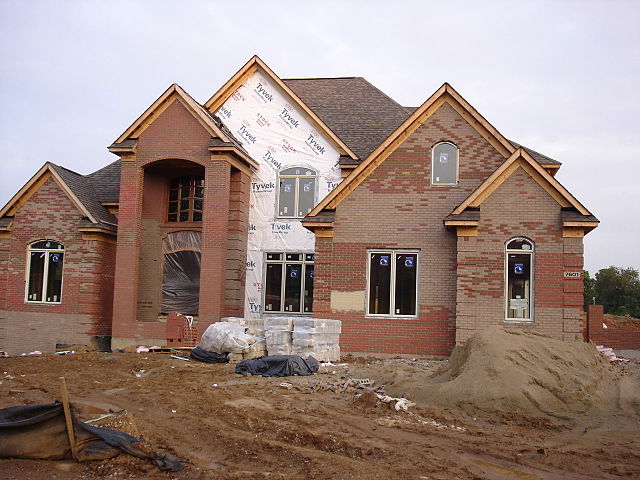
A “McMansion” being built in Louisville, Kentucky. From https://flickr.com/photos/merfam/174212265/ courtesy Wikipedia Commons.
“Good fences make good neighbors.”
Robert Frost’s well-known line from “Mending Wall,” written about his 1913 England neighborhood, still holds up in 21st century Santa Barbara, where the City Council approved a plan on Tuesday to almost triple the size of an 806-square-foot home on the Mesa, thrilling one family and devastating another.
Although the debate centered around Hans and Ginny Miller’s request to remodel their home at 221 San Clemente Drive, at the core of the discussion was a larger community dilemma that both neighbors and city leaders are struggling with — mansionization or expansionization of once modest tract homes.
Often selling for over $1 million, one-bathroom houses built in the 1950s are being converted into two-story contemporary homes with multiple bedrooms and baths. Some see this type of change as inevitable. “It’s a natural occurrence that people who can now afford lots on the Mesa want bigger homes,” said Arlie Skov, who lives on Shoreline Drive.
Other neighbors spoke of buying their small homes with the intention of growing their houses. “Families need room to grow,” that Roger Moore, a neighbor who spoke in support of the project.
While one of the arguments against second story expansions is the infringement on neighbors’ privacy, Jennifer Moore spoke of the charms of close proximity. “My neighbor to the right has a two-story house that looks down into our backyard. She comments on how quickly our puppy is growing. Children of other neighbors ride bikes and trikes up and down our sidewalk, none of this infringes on our privacy. This defines the neighborhood.”
However, not everyone supports the changes. While the Miller’s next-door neighbors, Jason and Sarah Dodds, brought the appeal to the Council, they had the support of several neighbors and neighborhood groups.
“As difficult as it is for the Millers, it’s equally difficult for those of us trying to preserve our Santa Barbara lifestyle,” said Eric Schott, a neighbor and one of the members of the Marine Terrace Preservation Group, which is working to “stop the mansionization of the Mesa.”
The Allied Neighborhood Association, which represents a consortium of neighborhood groups from all over the city, was also against the project. The board of directors sent a letter to the city stating, “If the proposed project is constructed, it could establish a bad precedent for Marine Terrace that would result in further adverse impacts. … The proposed project would destroy the intactness and integrity of San Clemente Drive.”
Ultimately the majority of the City Council supported the project because of the extensive review process — which started in March 2003 — rather than the merits of the design itself.
“The applicants have been through too much,” said Councilman Brian Barnwell. “I support denying of the appeal but recognize the merits.”
Councilman Dr. Dan Secord agreed, saying at this point it would be inappropriate to ask the homeowners to do anything more because they had worked through the city process.
“This project kind of reminds me of the kid who got passed through school year after year, and, the next thing you know, he’s 18 and can’t read,” said Dr. Secord. Still, he was comfortable with it. “This is not a mansion.”
With Mayor Marty Blum absent, Councilman Das Williams cast the lone dissent, urging his colleagues to look at the bigger picture and the social costs of changing the character of the Mesa from working class to middle and upper class houses.
